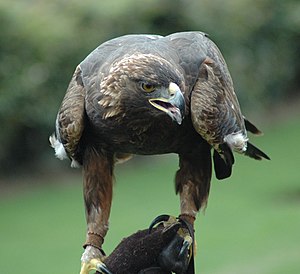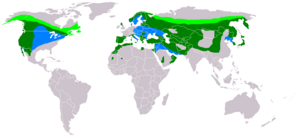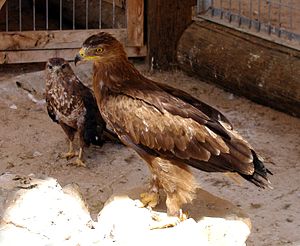Difference between revisions of "Field Guide/Birds/Aquila chrysaetos"
m (362 revisions: re-import from WB, including edit history) |
|||
| (287 intermediate revisions by 78 users not shown) | |||
| Line 1: | Line 1: | ||
| − | {{ | + | {{Bird id |
| − | + | | name = Golden Eagle | |
| − | + | | latin_name = Aquila chrysaetos | |
| − | + | | level = 4 | |
| − | + | | image_1 = GoldenEagle-Nova.jpg | |
| − | + | | caption_1 = Golden Eagle | |
| − | + | | image_2 = | |
| − | + | | caption_2 = Adult Golden Eagle in flight | |
| − | + | | image_3 = Golden eagle.jpg | |
| − | + | | caption_3 = Adult and juvenile | |
| − | + | | range_map = Aquila_chrysaetos_dis(Aiger).png | |
| − | + | | range_map_caption = World distribution of the golden eagle<br>Light green = Nesting area <br> Blue = Wintering area <br> Dark green = All year distribution | |
| − | + | | description = The '''Golden Eagle''' (''Aquila chrysaetos'') is one of the best known birds of prey in the Northern Hemisphere. | |
| − | The | + | A pair of Golden Eagles remains together for life. They build several eyries within their territory and use them alternately for several years. The nest consists of heavy tree branches, upholstered with grass. |
| − | + | Old eyries may be {{units|2 meters|6.6 ft}} in diameter and {{units|1 meter|3.3 ft}} in height, as the eagles enlarge their nests every year. If the eyrie is situated on a tree, supporting tree branches may break because of the weight of the nest. | |
| − | + | The female lays two eggs between January and May (depending on the area). After 45 days the young hatch. They are entirely white and are fed for fifty days before they are able to make their first flight attempts and eat on their own. In most cases only the older chick, which takes most of the food, survives, while the younger one dies without leaving the eyrie. | |
| − | + | Adult Golden Eagles have an average length of {{units|75-85 cm|30-34"}}, a wingspan of {{units|150-210 cm|59-83"}}, and a weight of {{units|3-5 kg|7-11 lb}}. As in all birds of prey, the females are generally slightly larger than the males. | |
| − | + | The plumage colors range from black-brown to dark brown, with a striking golden-buff crown and nape, which give the bird its name. The juveniles resemble the adults, but have a duller more mottled appearance. Also they have a white-banded tail and a white patch at the carpal joint, that gradually disappear with every moult until full adult plumage is reached in the fifth year. | |
| − | + | Golden Eagles often have a division of labor while hunting: one partner drives the prey to its waiting partner. They have very good eyesight and can spot prey from a long distance. The talons are used for killing and carrying the prey, the beak is used only for eating. The talons of a Golden Eagle are thought to be more powerful than the hand and arm strength of any human being. | |
| − | + | }}<noinclude>[[Category:Adventist Youth Honors Answer Book/Transcluded Modules|{{FULLCHAPTERNAME}}]]</noinclude> | |
| − | |||
| − | |||
| − | |||
| − | |||
| − | |||
| − | |||
| − | |||
| − | |||
| − | |||
| − | |||
| − | |||
| − | [[ | ||
| − | {{ | ||
| − | |||
| − | |||
| − | |||
| − | |||
| − | |||
| − | |||
| − | |||
| − | |||
| − | |||
| − | |||
| − | |||
| − | |||
| − | |||
| − | |||
| − | |||
| − | |||
| − | |||
| − | |||
| − | |||
| − | |||
| − | |||
| − | |||
| − | |||
| − | |||
| − | |||
| − | |||
| − | |||
| − | |||
| − | |||
Latest revision as of 19:09, 5 July 2012
| Aquila chrysaetos (Golden Eagle) | |
|---|---|
| Description | |
| The Golden Eagle (Aquila chrysaetos) is one of the best known birds of prey in the Northern Hemisphere.
A pair of Golden Eagles remains together for life. They build several eyries within their territory and use them alternately for several years. The nest consists of heavy tree branches, upholstered with grass. Old eyries may be 2 meters The female lays two eggs between January and May (depending on the area). After 45 days the young hatch. They are entirely white and are fed for fifty days before they are able to make their first flight attempts and eat on their own. In most cases only the older chick, which takes most of the food, survives, while the younger one dies without leaving the eyrie. Adult Golden Eagles have an average length of 75-85 cm The plumage colors range from black-brown to dark brown, with a striking golden-buff crown and nape, which give the bird its name. The juveniles resemble the adults, but have a duller more mottled appearance. Also they have a white-banded tail and a white patch at the carpal joint, that gradually disappear with every moult until full adult plumage is reached in the fifth year. Golden Eagles often have a division of labor while hunting: one partner drives the prey to its waiting partner. They have very good eyesight and can spot prey from a long distance. The talons are used for killing and carrying the prey, the beak is used only for eating. The talons of a Golden Eagle are thought to be more powerful than the hand and arm strength of any human being. | |



